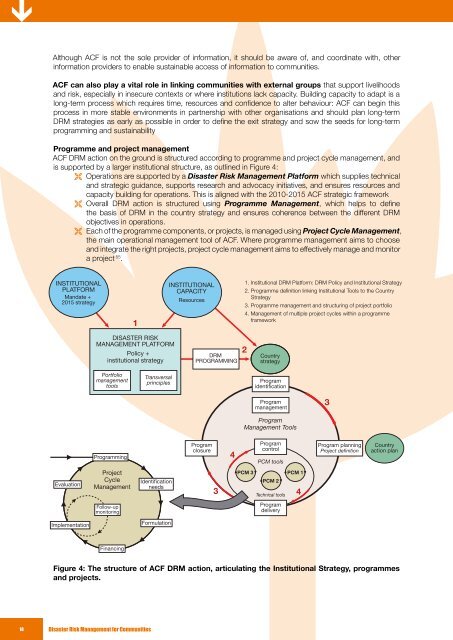DIsAsTER RIsk MANAgEMENT FOR COMMUNITIEs
DIsAsTER RIsk MANAgEMENT FOR COMMUNITIEs
DIsAsTER RIsk MANAgEMENT FOR COMMUNITIEs
- No tags were found...
Create successful ePaper yourself
Turn your PDF publications into a flip-book with our unique Google optimized e-Paper software.
Although ACF is not the sole provider of information, it should be aware of, and coordinate with, other<br />
information providers to enable sustainable access of information to communities.<br />
ACF can also play a vital role in linking communities with external groups that support livelihoods<br />
and risk, especially in insecure contexts or where institutions lack capacity. Building capacity to adapt is a<br />
long-term process which requires time, resources and confidence to alter behaviour: ACF can begin this<br />
process in more stable environments in partnership with other organisations and should plan long-term<br />
DRM strategies as early as possible in order to define the exit strategy and sow the seeds for long-term<br />
programming and sustainability<br />
Programme and project management<br />
ACF DRM action on the ground is structured according to programme and project cycle management, and<br />
is supported by a larger institutional structure, as outlined in Figure 4:<br />
± ± Operations are supported by a Disaster Risk Management Platform which supplies technical<br />
and strategic guidance, supports research and advocacy initiatives, and ensures resources and<br />
capacity building for operations. This is aligned with the 2010-2015 ACF strategic framework<br />
± ± Overall DRM action is structured using Programme Management, which helps to define<br />
the basis of DRM in the country strategy and ensures coherence between the different DRM<br />
objectives in operations.<br />
± ± Each of the programme components, or projects, is managed using Project Cycle Management,<br />
the main operational management tool of ACF. Where programme management aims to choose<br />
and integrate the right projects, project cycle management aims to effectively manage and monitor<br />
a project 55 .<br />
INSTITUTIONAL<br />
PLAT<strong>FOR</strong>M<br />
Mandate +<br />
2015 strategy<br />
1<br />
INSTITUTIONAL<br />
CAPACITY<br />
Resources<br />
1. Institutional DRM Platform: DRM Policy and Institutional Strategy<br />
2. Programme definition linking Institutional Tools to the Country<br />
Strategy<br />
3. Programme management and structuring of project portfolio<br />
4. Management of multiple project cycles within a programme<br />
framework<br />
DISASTER RISK<br />
MANAGEMENT PLAT<strong>FOR</strong>M<br />
Policy +<br />
institutional strategy<br />
DRM<br />
PROGRAMMING<br />
2<br />
Country<br />
strategy<br />
Portfolio<br />
management<br />
tools<br />
Transversal<br />
principles<br />
Program<br />
identification<br />
Program<br />
management<br />
3<br />
Program<br />
Management Tools<br />
Programming<br />
Program<br />
closure<br />
4<br />
Program<br />
control<br />
PCM tools<br />
Program planning<br />
Project definition<br />
Country<br />
action plan<br />
Evaluation<br />
Project<br />
Cycle<br />
Management<br />
Identification<br />
needs<br />
3<br />
PCM 3<br />
PCM 2<br />
Technical tools<br />
PCM 1<br />
4<br />
Follow-up<br />
monitoring<br />
Program<br />
delivery<br />
Implementation<br />
Formulation<br />
Financing<br />
Figure 4: The structure of ACF DRM action, articulating the Institutional Strategy, programmes<br />
and projects.<br />
18 Disaster Risk Management for Communities

















